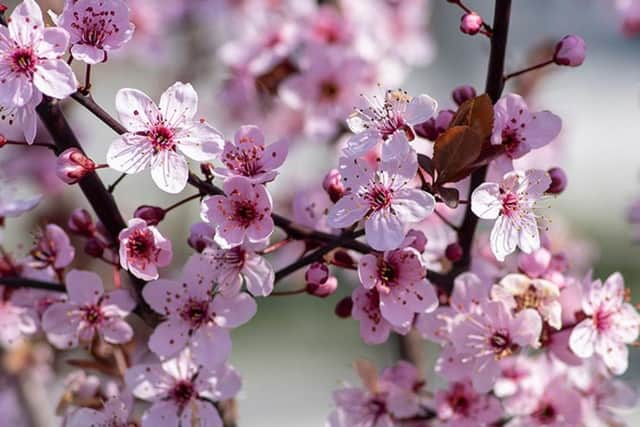Gardening Column: Spring is in the air... and there's plenty of work to be done
and live on Freeview channel 276
It’s the perfect time to get back into the garden and start getting ready for the summer months ahead.
As the soil starts to warm up all sorts of wildlife friendly plants can be added to the garden to encourage pollinator insects – especially bees.
Advertisement
Hide AdAdvertisement
Hide AdWith 25 species of bumblebees and more than 250 species of solitary bees, there are many that can be tempted into your garden if you choose plants carefully.


Some of the best include herbs such as rosemary, borage and thyme; annuals like wallflowers, nigella and cosmos; and perennials such as lavender, nepeta and dead nettles.
At this time of year cherry trees – both fruiting and ornamental – produce spring blossom in abundance which is much loved by bees.
Although tree planting is usually done in late autumn, fruit trees can still be planted in the spring and container grown varieties at any time of the year.
Advertisement
Hide AdAdvertisement
Hide AdCherry trees are easy to care for and come in all shapes and sizes so there is a variety to suit every garden.


Prunus ‘Pink Shell’ is a small, spreading ornamental cherry with delicate, cup-shaped pink flowers and pale green leaves that turn orange in autumn – it’s excellent for early pollinators.
A popular cherry that is great for small gardens for both flowers and fruits, is Prunus avium ‘Regina’ - producing clouds of pure-white blossom in spring, followed by large dessert cherries with superb flavour in summer.
The black cherry plum, Prunus cerasifera ‘Nigra’, is a beautiful, rounded tree and one of the first cherries to bloom in spring. It has dark purple leaves and masses of pink blossom that fades to white and the foliage turns spectacular shades of orange in autumn.
Advertisement
Hide AdAdvertisement
Hide AdIn addition to stocking your garden with bee friendly plants and trees, other top jobs for gardeners this month include: Sowing hardy annuals, herbs and wild flower seed outdoors - sowing seeds outdoors is an easy, inexpensive and fun way to grow new plants. Tying in climbing and rambling roses - rose pruning ensures that plants grow vigorously and flower well each year. Although often considered complicated, rose pruning is relatively easy. Repairing lawns - if your lawn is looking worn and patchy, now is the time to restore it by re-seeding or re-turfing affected areas.
Plus, here’s what the experts have to say:
Spring is finally in evidence as daffodils and flowering trees start to bloom. Expect the inevitable April showers this month but with sunny days too, when you can turn your attention to the lawn.
It’s an exciting month, with indoor-sown seeds well into growth, and it's also time to start sowing outdoors. Just watch out for frosts....
RHS
Mid-April is the perfect time to start sowing tender vegetables – in the greenhouse, conservatory or a sunny windowsill. In about six weeks, the risk of frost will be over and they will be ready to plant outside.
Kept warm, they will germinate, giving them a good four weeks to grow into young plants the right size for transplanting into the vegetable patch, once hardened off.
The English Garden